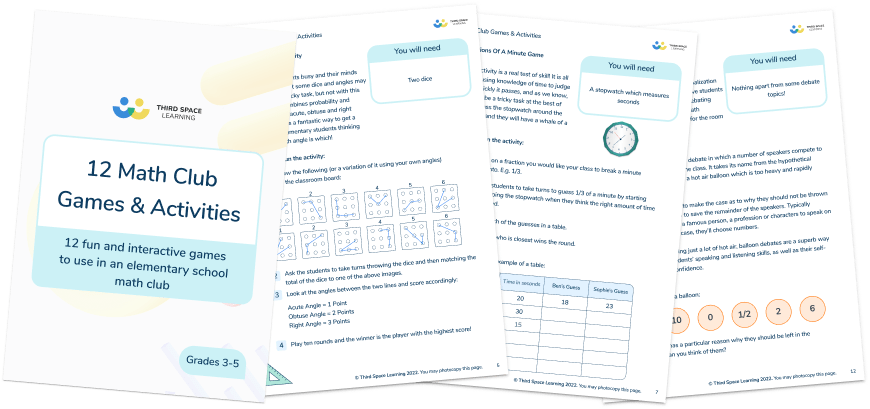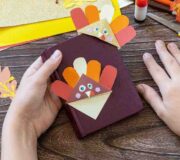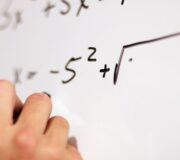18 Brilliant Mental Math Games To Build Number Fluency, Speed And Stamina In Elementary School
Mental math games are fun and play a key part of every elementary school classroom. When we are focusing on mental math, games can play an essential part in developing different mental math strategies, as many games reward accuracy and speed.
Games can be an excellent way to encourage participation in lessons, as well as improving attitudes towards the subject being taught. This blog gives suggestions for 18 different games that you could play to develop an array of mental math skills.
12 Math Club Games and Activities Grade 3 to 5
Download a free collection of interactive, fun math games and activities for elementary schoolers
Download Free Now!What are mental math games
Mental math games are a fun, low stakes way to develop childrens’ number fluency. These games are easy to organize as they require very few resources, relying on children’s ability to make calculations mentally.
Mental math games challenge students to identify number patterns and assess the most efficient methods for problem solving.
What are the benefits of mental math games?
There are various mental math strategies that children should be developing throughout elementary school that can be used to facilitate mental calculation, however these often require a level of number fluency and a flexibility with numbers.
Mental math is not simply recalling facts, instead it involves knowing and manipulating facts to answer different questions.
Another important skill that is developed when solving questions mentally is the ability to select the most appropriate method to answer a question. After playing some games, you may find it beneficial to ask your students what strategies they used to answer the question.
This can help children understand that there are a range of strategies that can be used and can begin a conversation about what method is best in what circumstance.
Third Space Learning’s online one to one online interventions are tailored to the needs of each student. We aim to fill the gaps in understanding and help children develop confidence and true fluency in math.
Our one to one lessons incorporate mental math into the learning objectives, encouraging children to attempt questions mentally. Our online lessons also focus heavily on mental math, dedicating the first part of each session to a range of arithmetic and mental fluency type questions.
In this blog, we provide 18 mental math games that you could use with your class. We recommend that you pick 3 or 4 games that work well for your class and adapt them for the lesson you are teaching.
By doing this, students won’t have to learn how to play a new game each time and can instead focus on the math. Where appropriate, we have provided a few suggestions of how the games can be adapted for different topics and grade levels.
When to use mental math games
There are several different points within a lesson that mental math games can be used. You can use mental math games as starters, at the end of a lesson or during a lesson.
By starting a lesson with a game, students will be engaged in the learning from the beginning. Carefully selected games that are played at the start of the lesson can also be used to quickly assess prior knowledge that is necessary for the lesson.
This also relies on carefully selected questions. Similarly, games used as a starter can recap essential skills from previous lessons, semesters or grade levels.
As with math starters (games used at the start of the lesson), games that are played during or at the end of the lesson can be used to assess the learning from the lesson being taught. When games are played at the end of the lesson, it ends the lesson on an exciting note, which is always enjoyable.
As a teacher, sometimes you can feel your class is no longer ‘with you’ and may need a bit of a break. Playing a game that is relevant to the lessons may re-engage your class and help them understand the content you’re covering.
It is important that you consider if the games you are playing are competitive or not. Adding competition to the lesson may help some students but it may produce anxiety in others.
Consider if it is more beneficial to work in groups or partners. This may change depending on the game played and the students you are working with.
A note on the mental math games below
To help you find your way around these mental math games, we’ve made suggestions as to the ones most suitable for upper and lower elementary.
However many of these mental math games epitomize low threshold, high ceiling math activities and you can continue to adapt them at any stage of the school.
Lower Elementary Mental Math Games
When young children first start learning, they tend to explore and play. Mental math games allow students to explore a math concept in a fun and engaging way.
The following games can be adapted so they can be played with students throughout their elementary years.
Mental Math Game 1: Bingo
This is a great mental math game that is very simple and can be adapted for a range of topics.
You will need: Individual whiteboards or a bingo board.
How to play:
- Students draw a bingo board on individual whiteboards.
- Tell the children to fill in their bingo board with numbers or words that relate to the topic given. (For example, if you are working on the two times tables, students can fill their board with multiples of two.)
- Ask a series of questions that relate to the given topic.
- The first person to cross off all the numbers on their bingo board and shout ‘bingo’, wins.
- As a class you can check the answers by going over the questions and sharing the answers.
Example of a variation for addition and subtraction, number bonds
Tell students to write numbers from 0 to 10 in the grid. Then ask the students questions, such as 2 + ____ makes 10. If they have 8 on their board, they can cross it off. Initially, with young children, you could use math manipulatives (such as counting cubes) to complete the board and ask children to work in partners or small groups.
This would develop not only math skills, but also develop communication skills.
Example of a variation for multiplication and division, multiplication tables
First, select a multiplication table to focus on and ask students to individually complete their board with the multiplication table (you could specify a range of multiples).
Ask times table questions and related division questions, varying the language you use (such as, ‘What are 5 groups of 4.’ or ‘20 shared between 5’) will help to expose students to the different vocabulary related to multiplication and division.
Example of a variation for 2D shapes, shape properties
First, students individually write the name of a shape in the bingo grid. You could specify that students include specific names of triangles or quadrilaterals, for example.
You can then describe the properties of a shape, and we would suggest that you clarify with the students the shape you are describing before moving on to the next shape (rather than recapping at the end).
This will ensure that the students all have clarity around the descriptions of different shapes, in case any were unsure before.
Mental Math Game 2: Ping Pong
This game works best with very simple counting but can be adapted to incorporate counting in topics other than place value.
You will need: n/a
How to play:
- Students need to be in pairs or two groups to play this game (the two groups could also be the whole class as a group and teacher as another group).
- Tell the students how you want them to count and the target number to end the game on.
- One person will start counting and the other student then responds with the next number (e.g. counting in multiples of 2, student A says, ‘2’ then student B says, ‘4’). You could also count backwards, if students are confident enough to do so.
- Counting continues until the students reach the target number or one student makes a mistake.
- This game can be ‘won’ in different ways. You could decide the first person to reach the target number wins. You could have it as a team game where they both win by reaching the target number without errors. You could have a point system where an error gives the other person a point.
Example of a variation for multiplication, two times tables
This game works best with skip counting (or multiples). Tell students to count in twos from 0 to 24. Initially, this game will be best played as a whole class against the teacher to demonstrate how to play, this will also help reinforce the correct answers.
You could use concrete or pictorial representations to support students when playing this game.
Example of a variation for fractions or decimals
Children need to know how to count in fractions, as well as decimals. Students could ping pong count in tenths from 0 to 1 (or more). By counting these out loud, rather than writing them down, it may help them to identify that tenths as a fraction and tenths as a decimal are the same but can be written differently (1/10 or 0.1).
For older children, you could ask them to count in different fractions/ decimals such as counting in two tenths starting from 1 tenth (1 tenth, 3 tenths, etc.) to add an extra level of challenge.
Mental Math Game 3: 21
21 is very similar to ping pong but is played with the whole class or within a small group, rather than pairs.
You will need: Individual whiteboards (if desired)
How to play:
- Tell the students how you want them to count and the end number (in this case, it is 21 but this can be changed).
- Go around the group counting in the stated way.
- Whoever says or goes over the end number first is out.
- Repeat this until there is an ultimate champion.
There are several ways to add challenges to this game. First, students could score points based on accurately predicting who will be the next person to go out. Give them time at the start of each round to write their prediction.
With this variation, there will be two overall winners, one who remained in the game the longest and one who accurately predicted who would be the next person out each round. This variation is useful to ensure all children remain engaged in the game.
Another variation is to allow the students to say between 1 and 3 numbers each time (their choice). This will add an element of strategy that can make it even more fun.
Similar to ping pong, this game is most suited to topics that involve counting such as place value, multiplication, fractions and decimals. Don’t forget that you can also ask students to count backwards to increase the challenge!
Mental Math Game 4: Run To The Answer
This is a very active game that requires a little bit of preparation beforehand. It isn’t the best game to use to assess students’ knowledge, but it is a fun game that can be used to get children moving.
You will need: Large digit cards or large answers
How to play:
- Set up a large space with digit cards/ answer cards spread out around the space. These should be easy to see (avoid putting them on the floor).
- Students start in the middle of the space.
- Shout a question and students run to the correct answer.
- Together chant the question and the answer (this helps students who may have followed the majority of the class to understand why the number they have ended at is the correct answer).
Example of a variation for lower elementary, place value, representing numbers
On the answer cards, have numbers represented in different ways (e.g. write ‘two’, show 5 using counters, use the digit 9 etc). Give students time to look at the different representations before starting.
Then say a number and students need to run to the representation of the number. When they have all decided on their answer, reiterate which number is represented.
Example of a variation for 3rd grade, 4th grade and 5th grade elementary, fractions, decimals and percentages
On the answer cards, have a range of different fractions, decimals and percentages. Give students time to look at the numbers before starting. Say a fraction, decimal or percentage that is equivalent to one on the answer cards.
Students then run to the equivalent fraction, decimal or percentage. When they have made their final decision, chant the equivalence together (e.g. 0.5 is equivalent to one half).
You could add individual points for the first person to say the missing equivalent (in this example, 50%).
Mental Math Game 5: Show The Answer
This is a similar game to ‘Run To The Answer’, but far less active. It works best with answers that can be expressed in numbers, although you could swap digit cards/ concrete resources for individual whiteboards to allow for more variation.
You will need: Digit cards or concrete resources (one or more set per group/ pair depending on the complexity of the questions you plan to ask)
How to play:
- Put students into pairs or small groups.
- Ask students a question. Students work with their partner/ group to use their digit cards to create the answer.
- Tell students to show their answers at the same time. Each pair/ group with the correct answer gets a point. You can decide how many points pupils need to win.
Example of a variation for 1st grade and 2nd grade, addition and subtraction
Ask students an addition or subtraction question. Depending on the skill you are focusing on, give students concrete resources, digit cards or both. Students can then work in partners or as a small group to show the answer using concrete resources or digit cards (or both).
The option of using concrete resources can prompt interesting discussions around the different ways that students may have represented the same answer.
For example, if the answer is 20, one set of students may have put cubes into two groups of 10 whereas another group may have put cubes into one line of 20.
Mental Math Game 6: Roll to Win
There are many different dice games that can be used to develop mental math skills. One of our favorites is ‘Roll to Win’ as it is incredibly easy to adapt for arithmetic questions.
You will need: One dice per student
How to play:
- First decide on the desired outcome of the game (see examples below for suggestions of how to vary this game for different topics and year groups)
- Put students into pairs. Each student will take it in turns to roll a die.
- When they have rolled the die, they select where to place their number to best meet the criteria. The person who is the closest to the criteria in the end is the winner.
Example of a variation for lower elementary, addition and/ or subtraction
Give students a target number (for example 50 for 1st grade). Students then take it in turns to roll their dice to make two, two-digit numbers with the target of making a equation that would have an answer as close to the target number (50 in this example) as possible.
You can decide if you want to use one operation or both.
Student A rolls 3, 2, 1, 4 and makes 34 + 21 = 55
Student B rolls 6, 1, 5, 3 and makes 16 + 35 = 51
Student B wins a point.
Example of a variation for upper elementary, multiplication, 3-digits multiplied by 2-digits
You can give the students a target number or the challenge of making the largest or smallest product possible. Students can then take turns, rolling their die and making a one 3-digit number and one 2-digit number.
Whoever makes the target number or the highest or lowest product (depending on your choice) wins a point.
Mental Math Game 7: Card Game Calculations
You will need: A pack of cards (jokers and faces removed or assigned values)
Similar to dice, cards can have many uses in mental math games. The easiest card game to play is revealing two cards and adding the numbers together, whoever is the quickest wins the cards.
This can be adapted as students start to learn their times tables by including multiplying the numbers on the cards together.
As students get older, they could move on to revealing multiple cards to make 2-digit numbers or more and use any of the four operations to create a calculation.
Mental Math Game 8: Noughts and Crosses Math
Noughts and crosses is a great game to adapt as so many children know how to play it already. This reduces the time you will need to explain how to play and win and gives students more time to focus on the math questions, while still having fun.
You will need: A nought and cross board filled with calculations/ images/ representations depending on the aim of the game.
How to play:
- Be the first to make an uninterrupted line of noughts or crosses on the board.
- To place a nought or cross, first answer the question correctly.
- If the answer given is incorrect, then the square is left open for anyone else to claim and play passes to the next person.
Example of a variation for lower elementary, 2D shapes
Put images of 2D shapes on the grid. Students have to name the 2D shape before they can claim the shape. This would also work for physical 3D shapes. students could then keep the 3D shapes to prove they knew the name.
There could also be repeated shapes in the grid to help encourage the use of accurate language for those who are less confident.
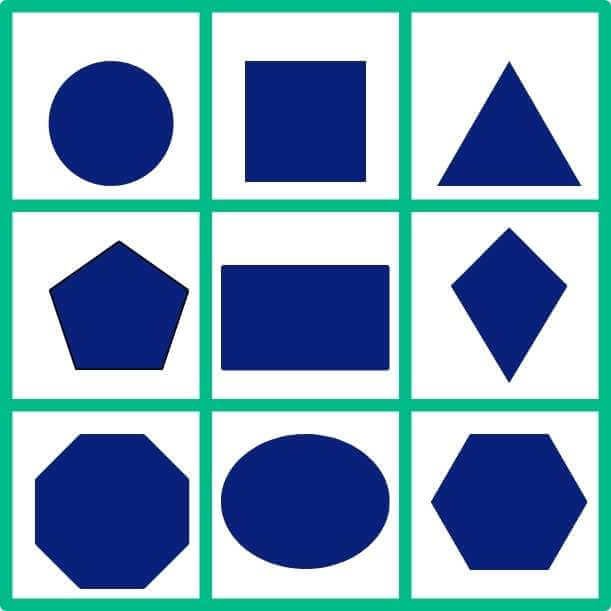
Example of a variation for upper elementary, division
Either fill the grid with division calculations that students can answer or fill the grid with numbers. With the second option, students would have to say a calculation that would have the given number as the quotient.
Mental Math Game 9: What’s My Number?
This game can be played in pairs, small groups or as a whole class. It can be easily adapted for the topic you are teaching and can have lots of ways to win or have praise awarded.
You will need: Individual whiteboards or sheets of paper
How to play:
- Give students time to think of and write down a set of 3 to 5 clues for a number/ shape/ value that is related to a given topic.
- Whoever is going first (you may wish to create a set of statements yourself for the first few rounds of this game to demonstrate the type of statements to use) reads out their first clue and asks for guesses for their number/ shape/ value.
- If no one guesses the correct answer, they then say their second statement. This continues until the number/ shape/ value has been guessed. You could add points for the person who guesses the answer first but also for the person giving clues as a way to encourage good, usable clues.
The clues you use can vary in difficulty depending on the grade level group you play with. In lower elementary grade levels, you may introduce a clue involving half or a third, whereas in upper elementary grade levels, you may introduce square numbers or equivalent percentages to add challenge.
This game can be adapted for topics such as telling the time, where you can describe the position of the hands on an analogue clock.
Upper Elementary Mental Math Games
We suggest that the following mental math games are more appropriate for upper elementary grades as they are slightly more complex than the previous games. These games incorporate number skills taught in 3-5 grade and aim to help children to develop these skills.
Mental math skills are particularly important as students prepare to move into middle school. Being able to quickly make calculations mentally and select the most efficient methods for solving problems is key for success in middle school math.
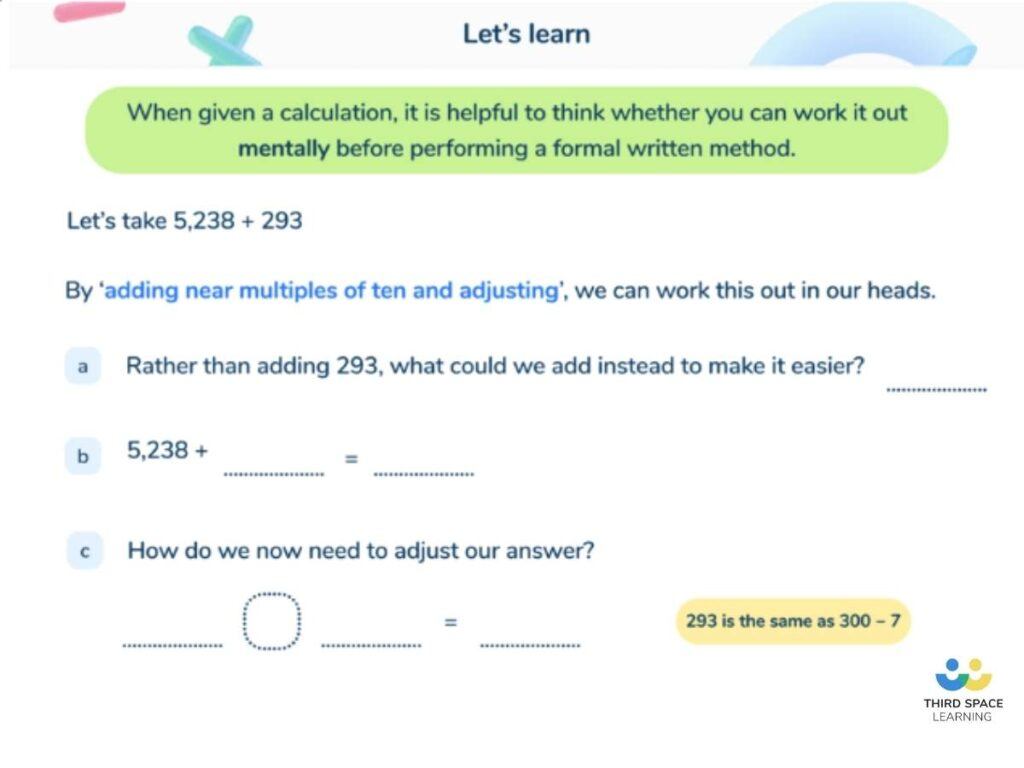
Mental Math Game 10: Treasure Hunt
This game can be either a very calm and quiet game or extremely active, depending on how you decide to play it.
You will need: A set of loop cards (between 5 and 10 would be more than enough), a room or a space
How to play:
- Set up some loop cards around the room/ space before the lesson (it is important that they are randomly placed).
- Students can work individually, in pairs or in groups for this task.
- Task students to find their way around the room by finding a question then finding its related answer.
- You may decide that the first student/ group to accurately find each question/ answer is the winner or you may decide not to have a ‘winner’, instead focusing on enjoying the game.
You can very easily adapt this game for any topic.
Mental Math Game 11: Zap
This is a very enjoyable whole class game that works best with arithmetic calculations.
You will need: n/a
How to play:
- Students stand back to back and take 3 steps away from each other.
- A question master (this could be yourself or a student) asks a question. They must know the answer to the question.
- The first pupil to turn around and say ‘zap’ followed by the correct answer is the winner of the round. They stay on while another student takes their place.
To add whole class competition, you could split the class in half and have the players representing their half of the class.
Mental Math Game 12: Splat
Splat is very similar to zap but involves a few more instructions and all students to focus. This is another game that works best with arithmetic questions, which can include fraction, decimals and percentages.
You will need: A large space
How to play:
- A question master (this could be yourself or a student) stands in the middle. The rest of the class make a circle around the question master.
- The question master points at one student and says a question.
- The student being pointed at ducks down, the students on either side of the ducking person attempt to be the first to answer the question and ‘splat’ the other student. (If the student who is pointed at forgets to duck down, they are out and sit down.)
- Whoever is first wins the round and the other student sits down. The student who had ducked can stand again.
This game can be played as a quick fire game. When two students are left, they can play back to back (similar to zap) to decide who is the overall champion.
Mental Math Game 13: Around the World
This game involves all students in the class and can cover a range of topics.
You will need: n/a
How to play:
- All students stand up (or, if you prefer, sit on their desk).
- The teacher goes around the class asking each student an individual question. These questions can be differentiated for each student.
- If the student answers the question incorrectly, they sit back in their chair.
- You can continue to go round the class until there is one student left.
This game can be played with arithmetic questions but also with other topics. If you are working on telling the time, this game can be played with a teaching clock to display a new time for each student. Similarly, if you are teaching a topic such as 2D shapes, you could display different shapes on the whiteboard for each student to identify.
Mental Math Game 14: Hands Up
Hands up offers an alternative to the traditional games where students need to provide the correct answer to a question. This game can be used as a quick assessment point but be aware that students may not know the answer and instead be copying the rest of the class. Hands up is another example of a game that can be easily adapted for all mathematical topics.
You will need: n/a
How to play:
- Write a number, word or general answer where students can see.
- Ask the students a series of questions. If the answer to the question is the one you have given, they put their hand up. If it is not they keep their hand down (this could also be standing or sitting).
- If the answer does not match the given answer, ask students to give the correct answer.
You can adapt this game by putting students into pairs or small groups so they can decide together if they put their hands up or down. This would promote mathematical discussions.
Mental Math Game 15: Beat the Teacher
Beat the teacher is an excellent way to encourage students to work together to solve math problems.
You will need: n/a
There are two ways to play this game.
How to play (version 1):
- A student is the question master (or a series of students are the question masters). They must know the answer to the question.
- A student is selected to play against the teacher.
- A question is asked, whoever answers first wins a point (teacher or the class).
How to play (version 2):
- Either the teacher is the question master or a student is the question master.
- A student is asked a question, if they answer correctly, the class wins a point. If they answer incorrectly, the teacher wins a point.
Both versions of this game are easily adaptable for arithmetic operations and can be adapted for some other topics with relative ease (for example arithmetic involving measures).
Mental Math Game 16: Beat the Clock
This game can be played as an individual challenge or as a beat the teacher challenge. Beat the clock can be adapted for all topics but, as the focus is on mental math, avoid topics that would be best solved using a written method.
You will need: A worksheet with questions, a timer
How to play:
- Hand out worksheets upside down (encourage students to avoid looking before the timer starts).
- Set a timer.
- When all students are ready, start the timer. Students will have this time to answer as many questions as they can. They can record the amount of time they have left once all the questions are completed. Alternatively, they can attempt to race to answer all the questions before the teacher or before the timer finishes.
Mental Math Game 17: Catch the Calculation
This is a very simple game that can be played with the whole class.
You will need: a beach ball
How to play:
- Write questions on the beach ball (this is another game that works best with arithmetic questions).
- Throw the beach ball to a student. When they catch the ball, they read out loud one of the two questions their thumbs cover (this gives them a choice of questions to answer) then they answer the question.
- When they have finished, they throw the beach ball to someone else who repeats the process. You could add a timer to see how quickly you can get through the whole class with only correct answers.
Mental Math Game 18: Who Wants To Be A Millionaire?
Although some students may be unfamiliar with the television show this game is based on, it is an excellent way to answer questions with reduced pressure. This game can be adapted for all topics.
You will need: A set of 15 questions that increase in difficulty as they progress
How to play:
- Students can work as a whole class or in groups. In both cases, one student should be nominated to answer each question.
- Explain that each question will have 4 possible answers and that each team (if in teams) will have the option of using phone a friend, ask the audience or 50/50, but they can only use each once.
- Play through the questions to see how far they get. You could add the incentive of points that build up to a reward if that helps motivate the class.
More mental math games and resources
Looking for more resources to strengthen your students’ mental math? Take a look at our collection of math games for each grade level:
- Grade 2 math games
- Grade 3 math games
- Grade 4 math games
- Grade 5 math games
- Grade 6 math games
- Grade 7 math games
- Grade 8 math gamese
Mental math games in the classroom
Games are a great way to kick off a math class or conclude a lesson. Hopefully, these mental math games and teaching ideas can be successfully deployed in the classroom, or serve as inspiration as you develop your own and be a helpful tool to get students engaged.
As students progress and get more confident with certain mental math skills, freely adapt these games with more complex questions to further challenge your students to continuously expand their mental math practice.
Do you have students who need extra support in math?
Give your students more opportunities to consolidate learning and practice skills through personalized math tutoring with their own dedicated online math tutor.
Each student receives differentiated instruction designed to close their individual learning gaps, and scaffolded learning ensures every student learns at the right pace. Lessons are aligned with your state’s standards and assessments, plus you’ll receive regular reports every step of the way.
Personalized one-on-one math tutoring programs are available for:
– 2nd grade tutoring
– 3rd grade tutoring
– 4th grade tutoring
– 5th grade tutoring
– 6th grade tutoring
– 7th grade tutoring
– 8th grade tutoring
Why not learn more about how it works?
The content in this article was originally written by math resource producer Hannah Searle and has since been revised and adapted for US schools by elementary math teacher Christi Kulesza.

